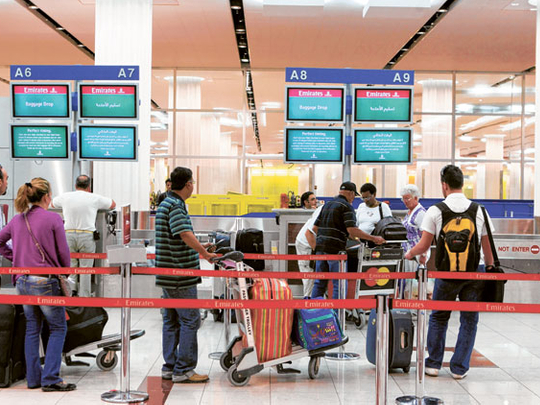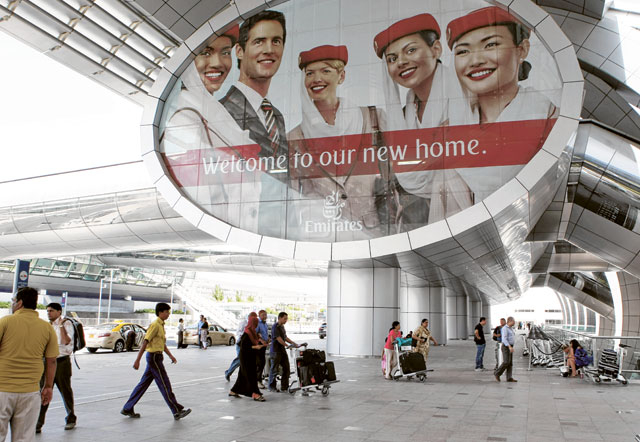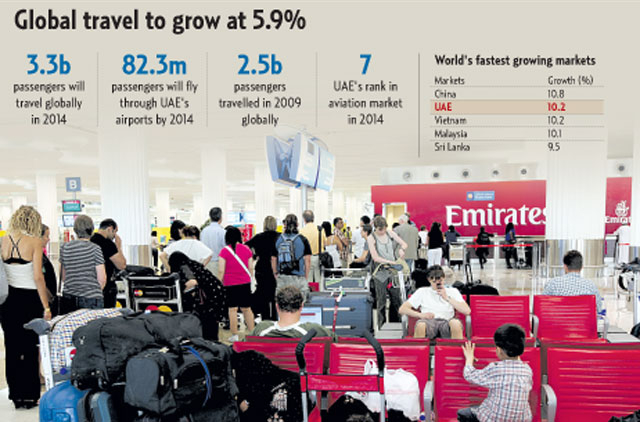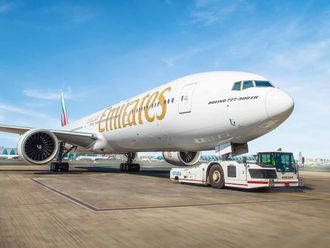
Dubai: The UAE is going to be the world's second fastest growing aviation market with 10.2 per cent growth by 2013, only lower than China which is expected to grow by 10.8 per cent, according to International Air Transport Association (Iata), the global aviation watchdog.
International passenger numbers are expected to rise from 952 million in 2009 to 1.3 billion passengers in 2014. This 313-million traveller increase reflects a compound annual growth rate (CAGR) of 5.9 per cent, Iata said.
"The fastest growing markets for international passenger traffic will be China [10.8 per cent], the UAE [10.2], Vietnam [10.2], Malaysia [10.1] and Sri Lanka (9.5)," Iata said in a statement yesterday.
As a region, the Middle East is expected to have the fastest growth rate at 9.4 per cent.
"The UAE, Kuwait, Jordan will be among the top 10 fastest growing countries, with the UAE ranked 7th for international passengers at 82.3 million. International freight demand will grow 8.1 per cent as freight links to and via the region continue to develop. The UAE will lead the region, handling 2.7 million tonnes of cargo," the report says.
"The Middle East accounts for about ten per cent of the international passenger market, is also one of the fastest growing regions, and has recovered much faster than any other region," said John Siddharth C.P, aviation analyst with Frost & Sullivan.
"However, the [Middle East airlines'] profit margins are expected to dip from $700 million [Dh2.57 billion] in 2010 to $400 million in 2011. The key reason for the reduction in profit margin is intense pricing strategies apart from the other factors that include expected rise in oil prices and uncertain economy."
The industry forecast by Iata indicates that by 2014 there will be 3.3 billion air travellers, up by 800 million from the 2.5 billion in 2009. By 2014 international aviation will handle 38 million tonnes of air cargo, up 12.5 million tonnes from the 26 million tonnes carried in 2009.
Industry focus
"The focus of the industry continues to shift eastward. By 2014, 1 billion people will travel by air in Asia Pacific. That's 30 per cent of the global total and a 4 percentage point increase from the 26 per cent it represented in 2009. The same is true for cargo where Asia Pacific will account for 28% of global volumes," said Giovanni Bisignani, Iata's Director-General and CEO.
China will be the biggest contributor of new travellers. Of the 800 million new travellers expected in 2014, 360 million (45 per cent) will travel on Asia Pacific routes and of those 214 million will be associated with China (181 million domestic and 33 million international). The United States will remain the largest single country market for domestic passengers (671 million) and international passengers (215 million).
"Despite some regional differences, the forecast indicates that the world will continue to become more mobile. This creates enormous opportunities but also presents some challenges. In five years we need to be able to handle 800 million more passengers and 12.5 million more tonnes of international cargo. To realise the economic growth potential that this will bring, we will need even more efficient air traffic management, airport facilities and security programmes. Industry and governments will be challenged to work together even more closely," said Giovanni Bisignani, Iata's Director General and CEO.
"The shadow of the global economic recession is expected to remain over parts of the industry for some time to come. Sluggish growth rates in Europe and North America are not only the result of being mature markets. Lingering consumer debts, high unemployment and austerity measures will dampen growth rates," said Bisignani.
Sharp rise
By 2014, the top five countries for international travel measured by number of passengers will be the United States (at 215 million, an increase of 45 million), the United Kingdom (at 198 million with an increase of 33 million), Germany (at 163 million with an increase of 29 million), Spain (123 million with an increase of 21 million), and France (111 million with an increase of 21 million).
China will record the highest CAGR of 13.9 per cent and contribute an additional 181 million passengers. Other countries with double digit growth include Vietnam (10.9 per cent), South Africa (10.6 per cent), India (10.5 per cent), and the Philippines (10.2 per cent).
By 2014 the five largest markets for domestic passengers will be the United States (671 million), China (379 million), Japan (102 million), Brazil (90 million) and India (69 million).
International freight volumes are expected to grow at a CAGR of 8.2 per cent over the forecast period. Excluding the impact of the rapid post recession rebound in 2010, for the 2011-2014 period, the consensus view for air freight is that it will stabilise at 5 per cent CAGR. The top five fastest growing international freight markets over 2009-2014 will be Hong Kong (12.3 per cent), China (11.7 per cent), Vietnam (11.4 per cent), Chinese Taipei (11.3 per cent), Russian Federation (11 per cent).
Bisignani, however, cautioned of reducing profit margins. "Aviation is a unique industry. In 2011 we expect to generate almost $600 billion in revenues with the burden of $205 billion in debt. Aviation supports 32 million jobs and facilitates the global village by supporting $3.5 trillion in economic activity," Bisignani said.













